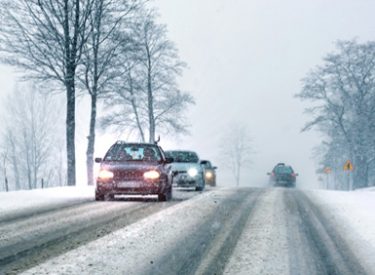Winter driving tips from AAA
Team Radio Marketing Group - January 5, 2017 12:45 pm

With winter weather quickly approaching, drivers should be sure their vehicles are ready to hit the icy and possibly snowy streets. Preventive maintenance is essential for safe driving and greatly decreases the chances of being stranded in the cold. Be prepared for adverse winter weather conditions with the following tips from AAA:
Before hitting the road…
-
Ensure engine performance. Replace the air filter as recommended by your car’s manufacturer. Get “check engine” lights investigated and quickly resolve drivability problems such as hard starting, rough idling, stalling or reduced power. Winter weather will likely make these issues worse.
-
Make sure your battery and charging system are up to par. A fully-charged battery in good condition is required to start an engine in cold weather. Have your battery and charging system checked for optimum performance – particularly if your battery is more than three years old. Also, clean any corrosion from battery posts and cable connections; wipe away dirt and oil deposits on the case and make sure all hardware is secure.
AAA members and non-members alike can request a visit from a AAA Mobile Battery Service technician who will test their battery and replace it on-site, if necessary. AAA Approved Auto Repair facilities can also test and replace batteries if they are a fixed battery site.
-
Check your windshield wipers and washers. Wiper blades should completely clear rain or snow from your windshield with each swipe. Replace blades that leave streaks or miss spots. For the winter months, purchase one-piece beam-type or rubber-clad winter blades to fight snow and ice buildup. In cold climates, be sure to fill the windshield washer reservoir with a cleaning solution that has antifreeze properties.
-
Keep an eye on your coolant. Check the coolant level when the engine is cold. If the level is low, add a 50/50 solution of coolant and water to maintain the necessary antifreeze capability. The level of antifreeze protection can be checked with an inexpensive tester available at any auto parts store. Also, check the condition of accessory drive belts and coolant hoses/clamps.
-
Inspect tires to ensure drivability on winter roads. Examine tires for tread depth, uneven wearing and cupping. Tires with less than 4/32” of tread will have reduced traction in wet and snowy conditions. Check tire pressure once a month before driving when tires are cold. In extreme climates, a set of winter snow tires or chains may be a wise investment.
-
Get a brake inspection. Have the brake system inspected by a certified technician as recommended by your car’s manufacturer. Brake inspection is needed if the fluid level is low, or you notice a brake pedal pulsation, steering pull, grinding sound or other unusual noise when braking.
-
Inspect your lights. Visibility is increasingly important in the dark winter months. Inspect all lights and bulbs and replace any that are burned out. Clean road grime or clouding from all lenses. Badly weathered plastic headlight lenses can be restored by professional services or using do-it-yourself kits available at auto parts stores.
-
Maintain the engine oil. For engine protection throughout the year, change the oil and oil filter at the intervals recommended by your car’s manufacturer. Always use an oil that meets the requirements of your vehicle’s manufacturer.
-
Check the transmission fluid. Make sure the transmission fluid is full and top off as necessary. Many newer cars have sealed transmissions that do not require fluid level checks unless there is a leak.
-
Always keep an emergency kit handy. Carry an emergency kit equipped for winter weather. The kit should include:
-
Bag of abrasive material (sand, salt, cat litter) or traction mats
-
Snow shovel
-
Snow brush
-
Flashlight with extra batteries
-
Window washer solvent
-
Ice scraper
-
Cloth or roll of paper towels
-
Jumper cables
-
Gloves, hats and blankets, enough for everyone who may ride in your car
-
Warning devices (flares or triangles)
-
Drinking water
-
Non-perishable snacks (energy or granola bars)
-
Extra clothes
-
First-aid kit
-
Basic toolkit (screwdrivers, pliers, adjustable wrench)
-
Mobile phone and car charger with important numbers programmed in it, including a roadside assistance provider
-
On the Road…
-
Stay alert.
-
Avoid driving if you’re tired. Getting the proper amount of rest before driving in winter weather reduces accident risks.
-
Never run a vehicle in an enclosed area, such as a garage.
-
Keep your gas tank at least half full.
-
Be cautious when driving in winter conditions.
-
Slow down. Adjust your speed to the road conditions and leave yourself ample room to stop. Allow at least three times more space than usual between you and the car in front of you. Accelerate, turn and brake gradually.
-
Do not tailgate. Normal following distances of three to four seconds on dry pavement should be a minimum of five to six seconds when driving on slippery surfaces. The extra time will provide additional braking room should a sudden stop become necessary.
-
Watch the traffic ahead. Slow down immediately at the sight of brake lights, skidding vehicles or emergency flashers.
-
Never use cruise control on slippery roads, as you lose the ability to transfer more weight to the front tire by simply lifting off the accelerator.
-
Avoid unnecessary lane changes. This increases the chances of hitting a patch of ice between lanes that could cause loss of vehicle traction.
-
Don’t power up hills. Applying extra gas on snow-covered roads may only result in spinning your wheels. Try to get a little inertia going before you reach the hill and let that inertia carry you to the top. As you reach the crest of the hill, reduce your speed and proceed downhill as slowly as possible.
-
Don’t stop going up a hill. It’s difficult to move up a hill on an icy road. If possible, get your vehicle moving on a flat roadway first before taking on a hill.
-
Minimize the need to brake on ice. If you’re approaching a stop sign, traffic light or other area where ice often forms, brake early on clear pavement to reduce speed. Vehicle control is much more difficult when braking on ice-covered roadways.
-
Control the skid. Slamming on the brakes can make the skid even worse. In the event of a skid, continue to look and steer where you want to go.
-
Do not brake and turn at the same time. Asking your vehicle to do two things at a time makes it more likely that your tires will lose traction. Brake first, then turn, then accelerate.
-
Know your brakes. If you have anti-lock brakes (ABS) and need to slow down quickly, press hard on the pedal. It’s normal for the pedal to vibrate a bit when the ABS is activated.
-
Drive distraction free.
-
Do not text or engage in activities that will distract you while driving. If driving with a passenger, ask them to carry out activities that would otherwise distract you from driving safely.
What to do in a winter emergency…
- Stay with your vehicle. It provides temporary shelter and makes it easier for rescuers to locate you.
- Don’t try to walk in a severe storm. It’s easy to lose sight of your vehicle and get lost in blowing snow.
- Don’t overexert yourself trying to push or dig your vehicle out of the snow.
- Tie a brightly-colored cloth to the antenna or place a cloth at the top of a rolled up window to signal distress. At night, keep the dome light on if possible. It only uses a small amount of electricity and will make it easier for rescuers to find you.
- Make sure the exhaust pipe isn’t clogged with snow, ice or mud. A blocked exhaust could cause deadly carbon monoxide gas to leak into the vehicle when the engine is running.
- Use whatever is available to insulate your body from the cold. This could include floor mats, newspapers or paper maps.
- If possible, run the engine and heater just long enough to remove the chill and to conserve gasoline.
- If possible, stay home…
- If you really don’t have to go out, stay home. Even if you can drive well in the snow, not everyone else can.



